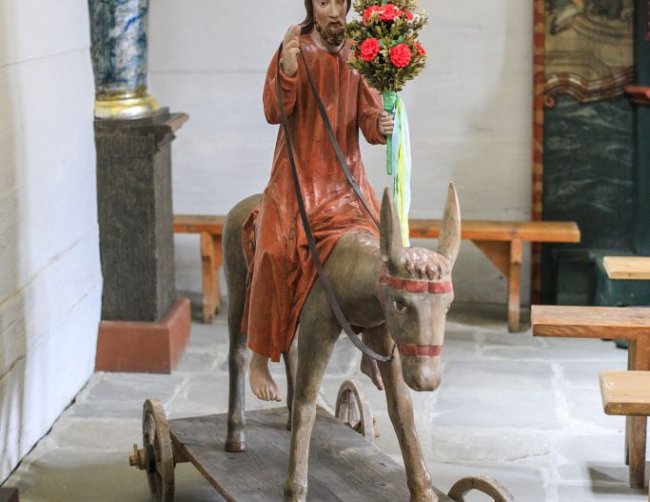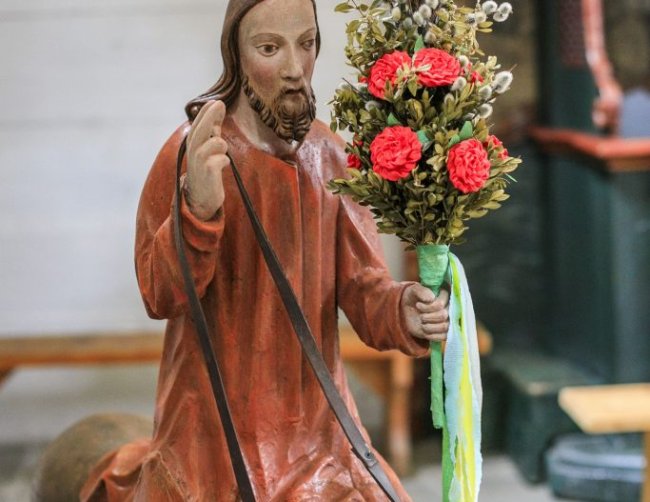Object
Figure "Christ on a donkey"
Information
Inventory no
MNS MP 753 S, KW MP 8803
Department
Ethnography Department
Technique
cast, dimensions: 151 x 136.5 x 75.5 cm
Material
polychrome wood-like mass, leather, metal
Copyright classification
https://pl.wikipedia.org/wiki/Domena_publiczna
Description
Placed on a four-wheeled cart, the sculpture of Christ on a donkey is a faithful copy of the figure from the first half of the 19th century. 16th century, from the Poor Clares monastery in Stary Sącz. It is made of wood-like mass, resistant to weather conditions, perfect for objects used and stored in changing climatic conditions. The sculpture was created to recreate the traditional Palm Sunday procession in the Sądecki Ethnographic Park, commemorating Christ's entry into Jerusalem. It shows Jesus dressed in a red robe, sitting astride a donkey, raising his right hand in a gesture of blessing, and originally holding a rein or a palm tree with his left hand.
The prototype of the sculpture in question is one of four representations of this type created in Poland and preserved to this day. The remaining objects come from: parish churches in Szydłowiec (3rd quarter of the 15th century)
and Rzepiennik Biskupi from the beginning of the 16th century (only a fragment of the figure of Christ preserved), located in the collections of the National Museum in Krakow, and from the church in the village of Rybie Nowe from around 1520, currently kept in the Diocesan Museum in Tarnów.
The source of the images of Christ on a donkey are the biblical descriptions of his entry into Jerusalem. Jesus arriving in the city was greeted by crowds of people with palm branches in their hands, spreading their robes before him. This event is commemorated in the Church's liturgy during Palm Sunday, and the oldest description of the ceremony of this holiday comes from around 400. In medieval Poland, processions looked different: they could take place between two temples, lead around the church or inside it. As throughout Europe, the way Christ was imagined was also different, personified in the form of a cross, a host, a book of Holy Scripture, a painting or a sculpture. Due to the small number of figures of Christ on a donkey preserved in Poland, they were probably not often used during this ceremony.
The iconography of the entry into Jerusalem comes from ancient depictions of triumphal, imperial entries into the city and, slightly modified, entered Christian art. The oldest examples of this representation date back to the 4th century and are found on early Christian sarcophagi. Depending on the way Christ sits on the donkey, two types of images can be distinguished - the Byzantine one showing Jesus riding the animal sideways and the Western one showing him riding astride. The earliest preserved sculptures of Christ on a donkey, used in the Easter liturgy, come from Western Europe and date back to the end of the 13th century. Around the same time, the iconographic scheme of these images was also developed: a large donkey stood on a flat platform equipped with wheels or carrying handles. On it sat Christ dressed in a long robe, blessing with his right hand, and usually holding the reins in his left, and rarely a book or a palm. In some sculptures, Jesus' head is surrounded by a crown of thorns or beams of rays.
Objects of this type were most common in German-speaking countries, and over 160 of them have been preserved to this day, the vast majority of which come from the turn of the 15th and 16th centuries, when processions with Christ on a donkey on Palm Sunday were very widespread. With the advent of the Reformation and later the Enlightenment, rituals using visual representations of holy images began to be criticized as a form of idolatry. Figures of Christ on a donkey lost their popularity at that time, and in extreme cases they were even destroyed.
Edyta Ross-Pazdyk



